How 4 Brands Successfully Capitalized on Viral Marketing Trends

How 4 Brands Successfully Capitalized on Viral Marketing Trends
Discover how businesses use social media trends to create some of the most memorable social media conversations of all time.
Sometimes, businesses respond to viral marketing trends in a way that propels their brand into the spotlight. Other times, their attempts at sass or relevancy have devastating consequences.
In this article, we’ll explore some of the most notorious successes and failures of real-time social media marketing, including:
- How multiple brands responded to IHOP’s name change
- How Oreo saved Super Bowl Sunday
- How Tide confronted a dangerous viral trend with humor and information
- How Yanni won over younger fans with his Yanny versus Laurel replies
How Multiple Brands Responded To IHOP’s Name Change
When IHOP announced it was changing its name to IHOB, it let fans speculate on what the “B” might stand for. The 7-day campaign was a social media hit, garnering over 18,000 comments and 13,000 shares on Twitter in a matter of days.
While fans were busy wondering if the “B” stood for bacon, burritos, or booze, Chiquita Bananas jumped into the mix by suggesting “International House of Bananas.”

When IHOP announced its new name, “International House of Burgers”, it admitted that the name change was a temporary ruse to promote their burger menus.
Many of IHOP’s competitors couldn’t resist the urge to exploit the publicity stunt. Brands like Wendy’s, Burger King, and White Castle took to Twitter with responses that showcased quick wit and banter, putting their own menus in the spotlight.
For example, White Castle burgers replied with its own spin, threatening to change its name to “Pancake Castle.”

Wendy’s burger chain mocked the restaurant chain with a sassy tweet: “Not really afraid of burgers from a place that decided pancakes were too hard.”
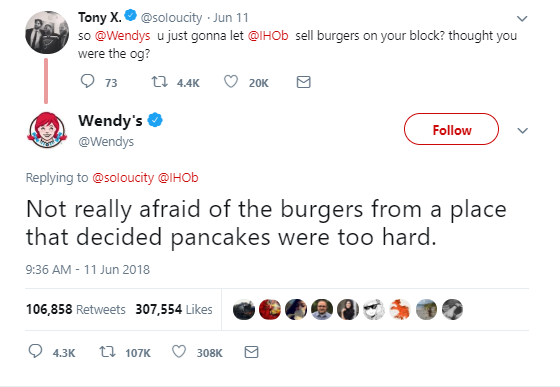
Burger King took it a step further by changing its logo and Twitter handle for a day, rebranding themselves to “Pancake King.”

What began as a campaign to promote IHOP’s burgers developed into an industry-wide competition that put a number of restaurants in the spotlight.
How Oreo Saved Super Bowl Sunday
During the New Orleans Super Bowl of 2013, the stadium experienced an electric outage that postponed the game by 32 minutes and left TV viewers bored and irritated.
In under 5 minutes, Oreo’s marketing team created a tweet that would later be referred to as “One of the best Super Bowl ads, bar none.”
The tweet simply said: “Power out? You can still dunk in the dark.” It was later raved about by many major news outlets, including the Wall Street Journal and Washington Post.
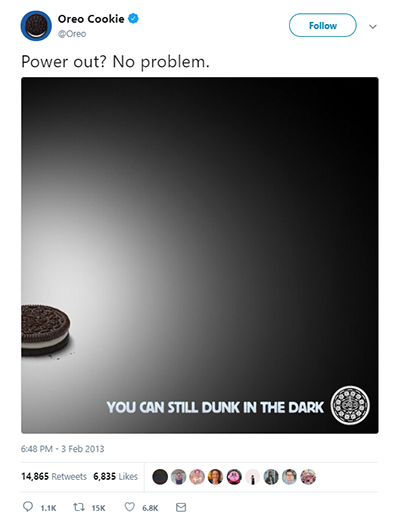
Oreo’s quick response was not a stroke of luck. The brand prepared for Super Bowl Sunday by gathering a team of 15 social media marketers who were ready and waiting to respond to anything that took place during the Superbowl.
The ad ended up generating more than 16,000 retweets and taking its place in the memory of both sports and marketing fans for years to come.
How Tide Confronted A Dangerous Viral Trend With Candor And Humor
When the dangerous trend of teens eating Tide Pods laundry detergent went viral, the brand could have buried its head in the sand, waiting for it to pass.
Instead of avoiding negative publicity, Tide tackled the issue head-on. In a video titled “What should Tide Pods be used for?”, the company addressed the dangerous trend with a balance of information and humor.
In a 21-second video, Tide explains how their pods should be used for “DOING LAUNDRY. Nothing else.” Professional football player Rob Gronkowski tells viewers “No, no, no, no, no” to eating Tide Pods.

One of the reasons the Tide video was such a success is because the brand understood the personality of its audience. At a time when adults were too frustrated to communicate the idiocy of the Tide Pod Challenge craze, Tide stepped in and spoke for them.
The brand was able to balance seriousness with humor in a way that had most people wondering “Why didn’t I think of that?”
Tide’s response to the deadly viral trend was shared over 94,000 times on Twitter.
How Yanni Won Fans With Yanny Versus Laurel Tweets
When a high school student in Georgia looked up the word “Laurel” on Vocabulary.com, she heard the word “Yanni” pronounced. Thinking it was a mistake, she asked her classmates to listen. Despite the fact they were all listening to the same recording, some heard “Yanny” while others clearly heard “Laurel.”
The recording made its way to Instagram and eventually got shared to Reddit where, pardon the expression, it “blew up the internet.”
During a period of political and economic crisis, the world welcomed the chance to discover which version of the Yanny/Laurel recording their own ears would hear. Brands and celebrities joined in the viral poll, and one man used it to boost his old-school reputation into a trending spotlight.
New-age solo pianist Yanni took to Twitter and posted a photo of himself laughing beneath the comment “The reaction you make when people think it’s Laurel and not Yanny.”
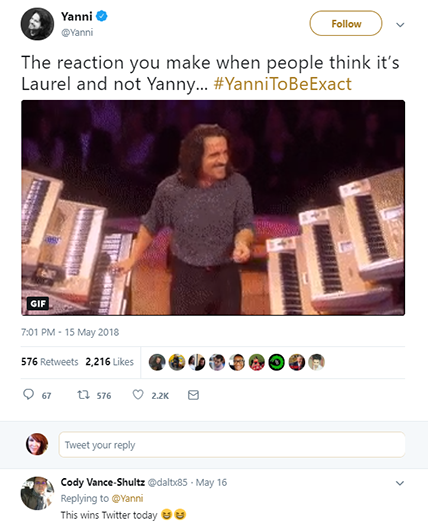
Yanni followed the trend with a series of tweets. One of the most popular included a video in which he listens to the recording, laughs, and then corrects the pronunciation to include a long “a” sound to mimic the correct version of his own name.
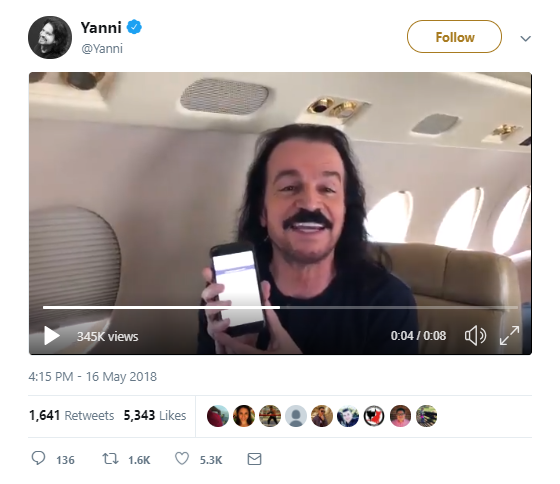
Yanni’s response earned over 1600 shares and 5000 likes on Twitter. More importantly, it kicked off a conversation with the younger generation that had previously written him off as “an old guy that plays the piano.”
As the Yanni vs. Laurel debate continued, Yanni’s popularity rose, and Google Trends noted that he received a spike in searches. Some people suggested Yanni could have done more to take advantage of the trend.
For example, one Twitter user shared a chart proving “Yanni music” had risen rapidly, beneath the comment “If Yanni were able to drop a new song right now and call it ‘Laurel,’ it would be the biggest social media/music coup of the year.”
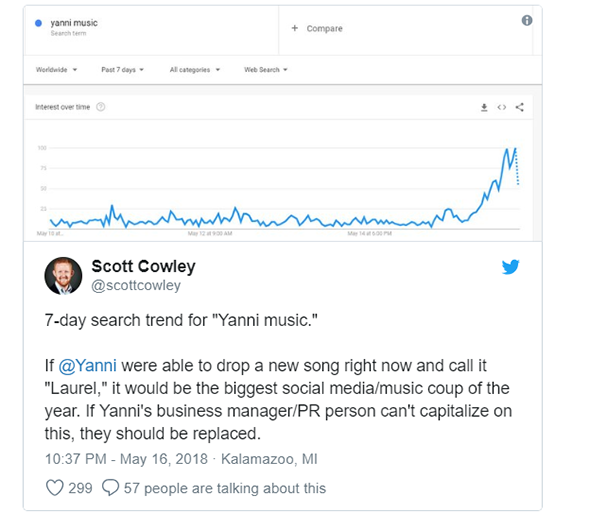
While Yanni was quick to respond and garner some newfound interest for his brand, he also may have missed an opportunity to further capitalize on the viral debate.
What Makes Real-time Viral Responses Work?
Staying on top of social media trends is the first step toward engaging with real-time social marketing. There are a number of tools that can help you do this, including:
- Twitter trends: The left-hand column of your Twitter homepages includes a “Trends for You” section.
- Buzzsumo: The paid app helps you discover trending social media in your industry.
- Facebook page “What’s Trending”: Facebook shut down its “Trending” feature in 2017, but there are pages you can follow, like What’s Trending and Yahoo Trending, that share current trends.
Responding to viral marketing trends is a high-risk strategy because quick responses raise the chance of mistakes. The internet is filled with stories of brands who missed the mark on social media, posting misunderstood messages with devastating consequences.
For example, despite its social media savvy with the IHOP name change response, Wendy’s had its own failure not long ago. When a fan asked the brand to share a meme, Wendy’s replied by posting an image of Pepe the Frog, unaware that the character had become an anti-Semitic hate symbol.
Despite the fact that Wendy’s immediately deleted the tweet and apologized, the incident offended their audience and angered a number of Jewish organizations enough to publish articles, write letters, and demand reparation.
While there’s no clear-cut answer to success for responding to viral moments, there are a couple things you can do to improve your chances of success and limit the chance of failure:
- Run your ideas past a diverse focus group or in-house team before you hit “publish.”
- Google your messaging and images before publishing. Be sure the idea hasn’t been done before, and that neither image nor wording is associated with a negative meaning.
- Provide thorough training to your team, and supply them with a written social media policy guide.
Teams Make Real-Time Response More Likely To Succeed
The examples we’ve studied in this article show that successfully capitalizing on viral marketing trends requires preparation. The most successful responses involve teams with a wide range of talent and personalities.
Teams can be used to:
- Apply a sense of humor and fun to trending situations
- Prepare for big events with standby teams that are ready to respond
- Address serious issues without turning away customers
Responding to real-time trends has the chance to dramatically improve your popularity across social media. Be sure to use caution and ask for input before you hit “publish” to avoid mistakes.
